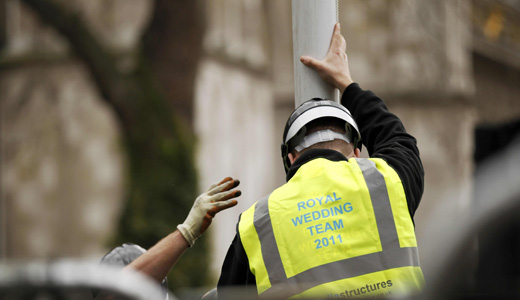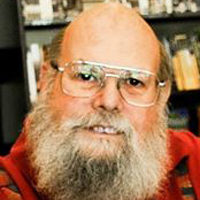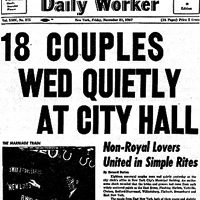
First off, columnist Walter Brasch opines:
Down for the count: America’s fascination with royalty
In case you’re in a funk because you didn’t receive an invitation to the British royal wedding, the American media have a solution for you.
The media had been pumping out news, features, and gossip about the wedding for more than three months. Almost every radio, TV, and cable network, except for maybe the Cartoon Channel, will be covering the wedding on Friday. All. Day. Long.
Coverage begins at 3 a.m. EDT (8 a.m., British Standard Time) and finally ends before the bars close. In addition to extensive live coverage of the procession and wedding itself, ABC, CBS, and NBC are devoting five hours in evening prime time to reviews of the wedding.
WE TV has four one-hour documentaries: “Prince William,” “Kate: The New Diana?”, “Will + Kate Forever,” and “William & Kate: Wedding of the Century.” Apparently, the cable network that brands itself as “the women’s network devoted to the wild ride of relationships during life’s defining moments,” believes there won’t be a royal divorce, and that the marriages of Charles and Diana (which did end in divorce), Grace Kelly and Prince Rainier, Elizabeth II and Philip, and Edward VIII and Wallis Simpson in the 20th century were only preliminaries. Lifetime, which bills itself as the cable network that “celebrates, entertains and supports women,” has several one-hour documentaries, including “A Tale of Two Princesses,” “William and Kate: A Love Story,” and “Kate’s Gown of Renown.” The network is also cablecasting two two-hour docudramas, “Prince William” and “William & Kate.”
If you don’t have access to a TV set, You Tube is transmitting the events live to computers and every handheld device known to technology. Add in all the newspaper and magazine coverage – look for multi-page photo spreads in all major entertainment magazines in the next week – plus a million or so blogs, and there’s no reason why anyone shouldn’t know important details, including how many canapés were ordered for the after-wedding reception.
Although we organized a revolution to overthrow a monarchy, and created a president not a king as head of State, Americans have always had a fascination with royalty.
Among googobs of literary and movie princesses have been Cinderella, Snow White, and Leia who helped Han Solo, Luke Skywalker, and that giant furry thing make the world safe for high-tech special effects. And, of course, there’s the Lion King that made the Disney company rich enough to devour all other media companies, and take on the corporate shape of Jabba the Hut.
The greatest baron, pursued by ace aviator Snoopy, was the Red Baron. However, for some reason the media prefer to use the title “baron” to refer to evil “kingpins”- as in “drug baron,” “robber baron” and, understandably, “media baron.”
The music industry abounds with royalty. Bessie Smith was the Empress of the Blues; Roger Miller was King of the Road. Among other kings are those of ragtime (Scott Joplin), blues (W.C. Handy), swing (Benny Goodman), waltz (composer Richard Strauss or bandleader Wayne King), pop (Michael Jackson), and, of course, Elvis, the king of rock and roll. One of the best singers was Nat “King” Cole.
Aretha Franklin is the Queen of Soul. Rap singer Queen Latifah may think she’s royalty, but British rock group Queen has a better shot at sitting in Buckingham Palace.
Among singing princes are the Fresh Prince of Bel-Air, who doesn’t do much singing or rapping any more, and Prince Rogers Nelson, who became known simply as Prince, and then the singer-with-the-unpronounceable symbol, who later regained a pronounceable moniker, and has the ability to predict purple rain.
Other less royal dukes have been baseball great Duke Snider and musical genius Duke Ellington who, had he gone to baseball games, would have had to sit in segregated seating in most ball parks. Sitting with him would be the Dukes of Dixieland. Upset there are no more segregated “colored” seats, drinking fountains, and rest rooms is David Duke who once cornered the market on pointy white hats and dull-witted whites.
Babe Ruth was the Sultan of Swat. But no royal monikers were attached to Roger Maris who broke Ruth’s single season record or to Hank Aaron, who broke Ruth’s lifetime record, and had to put up with numerous racist comments.
Nevertheless, the only royalty that matters to me are the Counts – Tolstoy, Dracula, and Basie.
Photo: Workers erect the broadcast platforms from which the world’s media will cover the royal wedding, outside Westminster Abbey in London. (Matt Dunham/AP)
Way back in 1947, British royalty staged a lavish marriage of Princess Elizabeth to the scion of a wealthy, titled German family, Philip Mountbatten, Duke of Edinburgh. The press devoted millions of words, entire pages and front page headlines to this event. On the day after the marriage our predecessor, the Daily Worker, under large headlines, ran the following page one story.
 18 couples wed quietly, Non-royal lovers united in simple rights
18 couples wed quietly, Non-royal lovers united in simple rights
by Bernard Burton
November 17, 1947.
Eighteen non-royal couples were wed quietly yesterday at the City Clerk’s office in New York City’s Municipal Building. An on-the-scene check revealed that the brides and grooms had come from such widely scattered points as the East Bronx, Flushing, Harlem, Yorkville, Chelsea, Bedford-Stuyvesant, Williamsburg, Flatbush, Bensonhurst and East New York.
The couple from East New York, both of them young and slightly awed, repeated the itinerary of their wedding procession as they waited in the anteroom, waiting for “next.” The bride, attired in a pale blue, flowered print dress, purchased a week earlier at a prominent 14th Street store, had left her mother’s three-room apartment, Van Siclen and Livonia Aves. At 9:30 a.m. to meet the grooms at the I.R.T.’s New Lots Ave. Station.
The bride wasn’t accompanied by her father, who had left several hours earlier for Manhattan to attend to his duties as a clothes presser in a building at Wet 37th St. The prospective mother-in-law was also unable to participate in the procession, being compelled to attend to her three-year-old grandson, whose working parents reside in the same three-room apartment.
Walking with a buoyancy which ignored the dull, chill morning, the bride hurried her steps as she spied the groom waiting at the foot of the stairs to the El. They greeted each other with a graceful embrace and a kiss which left hardly a smudge of Prince Feather Lipstick on the groom’s smiling lips.
The groom was also unescorted. He wore a gray suit, a topcoat, and the cool breeze ruffled his light brown hair. He was hatless.
The bride, who had ash blond hair, straightened her navy blue hat, which was trimmed with a wisp of veil, as the couple, holding hands, slowly climbed the steps. They were temporarily parted as the waiting crowd on the platform thronged abruptly into the same car.
The separation, however, lasted only to Utica Avenue, where they transferred for the Lexington Avenue Subway. This time, they vowed, there would be no separation. With the bride holding grimly to his waist, the groom, who stands five, ten inches, and weighs about 182 pounds, charged through the crowd. There was no seat for the non-royal couple. Nevertheless, the 20-minute ride to Brooklyn Bridge held its recompense. The couple stood close together, swaying in rhythm with the train, with the bride’s veil occasionally tickling the groom’s nose.
At Brooklyn Bridge they were hastily ejected from the car, but they again slowly mounted the steps, and made their way across the square which was crowded with cars honking their horns. Traffic police showed visible sign of losing their patience as they tried to keep the traffic moving.
As they reached the hallway to the City Clerk’s office, they were unceremoniously ushered into the anteroom by other brides and grooms seeking to be first in line. One couple thought that they were about fifth.
The groom, who wore a ruptured duck [a slang term for The Honorable Service Lapel Button worn by World War II veterans] on his lapel, arose suddenly as a clerk called two names. “That’s us, honey,” he said, and they walled into the office with two witnesses, who had met them in the anteroom. They were shopmates of the groom, who holds the post of polisher in a Brooklyn metal plant.
In the clerk’s office, a little tired man droned through the ceremony, waited for the ‘I do’s,” and declared, “I now pronounce you man and wife.”
They returned to the apartment of the bride’s family where her mother greeted the newlywed with: “The folding bed came from the store. We’ll put it up in the kitchen tonight.”
There were no gifts from the White House.
(The article also appeared in the book, Fighting Words: Selections from twenty-five years of The Daily Worker, New Century Publishers, New York, 1949.)











